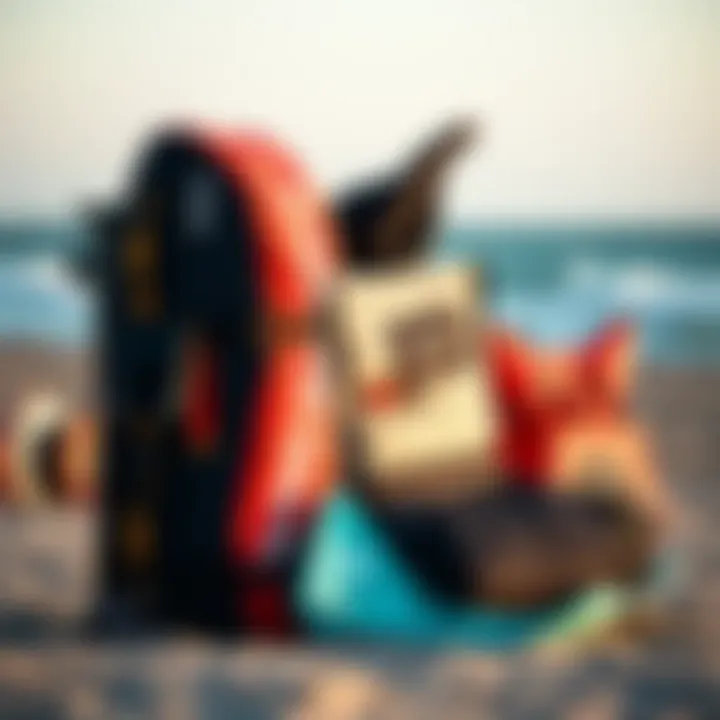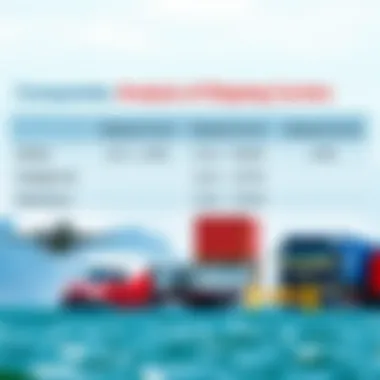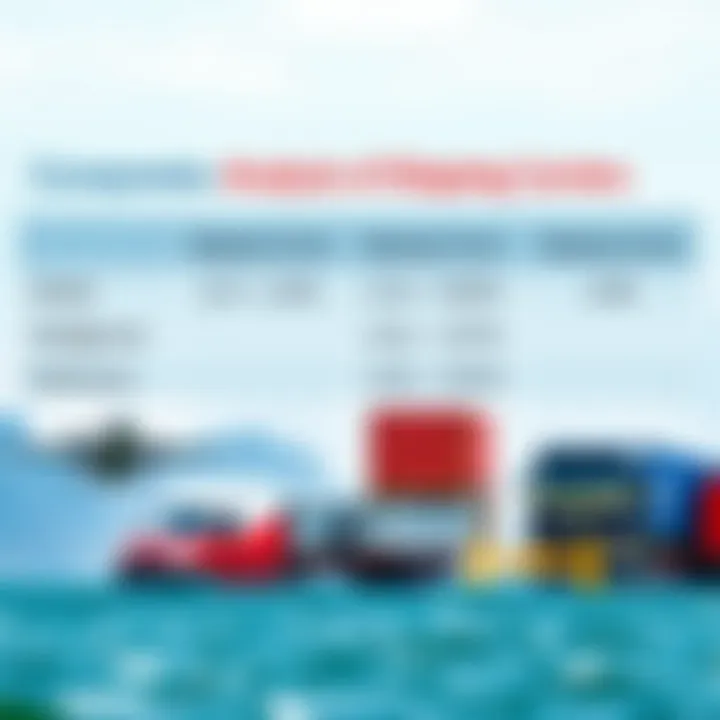International Shipping Solutions for Kiteboarding Gear


Intro
When it comes to kiteboarding, gear is everything. From kites to boards and harnesses, quality equipment can make or break your experience on the water. However, acquiring this gear often means navigating international shipping options, which can appear more confusing than a tangled kite line.
This guide intends to shed light on the various shipping methods available to kiteboarding enthusiasts who are eager to snag gear from global suppliers. Understanding these shipping options is not just a trivial pursuit; it’s a pragmatic necessity for anyone looking to optimize their kiteboarding setup.
With a jumble of shipping carriers, delivery times, and cost factors to consider, selecting the right option is paramount. Making an informed decision can significantly enhance your kiteboarding experience, making it smoother and hassle-free. From novice to experienced kiteboarders, knowing the ins and outs of shipping can save time and money, ensuring that you're not left high and dry without the right equipment when adventure calls.
Let’s warm up with some foundational insights on gear to ensure you know what’s worth shipping.
Understanding International Shipping
In the world of kiteboarding, purchasing gear often means navigating the complex web of international shipping. Understanding how this process works is crucial, as it can influence everything from costs to arrival times, ultimately affecting your ability to enjoy the sport you love. With kiteboarding gear sometimes being a niche market, enthusiasts frequently find themselves sourcing products from around the globe. Hence, a firm grasp of the nuances of international shipping plays a pivotal role in ensuring that these items arrive safely and on time.
Defining International Shipping
International shipping refers to the process of sending goods across borders, involving various logistics considerations. The journey of your kiteboarding gear may start in a small shop in California and end on a beach in Greece. This involves documentation for customs, potential tariffs, and various transport methods. In simple terms, if you’re buying something from another country, it falls under this umbrella.
The layers of complexity can differ based on the country of origin and destination. Some nations have stringent customs regulations, while others are more lenient, which can affect not only delivery times but also costs. The need for proper packaging, adherence to each destination’s regulations, and understanding shipping methods all come into play here. These elements become especially vital when dealing with larger or more valuable items, like kiteboards or specialized equipment.
Importance for Kiteboarding Enthusiasts
For kiteboarding enthusiasts, understanding international shipping is not just about receiving their product but ensuring that it meets the specific requirements for their activity. Kiteboarding gear often includes bulky items such as kites, boards, and harnesses. These aren’t just any packages; they require careful handling and someone who gets the need for high quality and precision in equipment.
Moreover, the landscape of availability changes dramatically when you look across borders.
- Access to unique products: Some brands and models might not be accessible in your local shops, compelling kiteboarders to explore international options.
- Price variations: Different regions offer varied pricing. What might be exorbitantly priced in one country, could be available at a bargain in another.
- Local regulations: Each location might have differing rules about gear importation, levying tariffs or prohibitions on certain items. Being aware of these nuances can save you headaches down the line.
Ultimately, understanding international shipping allows kiteboarders to make informed decisions and not get caught in unexpected delays or additional costs. The goal is to hit the waves, not to wrestle with shipping woes. This article will help navigate the winding paths of international shipping so that you can focus on what you truly enjoy – kiteboarding.
Shipping Methods Overview
When diving into the world of international shipping for kiteboarding gear, it's crucial to take a good, hard look at the different shipping methods available. These methods can vary greatly in terms of speed, cost, and reliability. Understanding your options helps kiteboarders like you make informed decisions that align with your needs, whether you’re gearing up for a season abroad or just restocking your local collection.
By grasping the benefits and considerations of each shipping method, you can better navigate the complexities involved in getting your kiteboarding equipment from around the globe to your doorstep. Now, let’s take a closer look at the three main shipping methods—Air Freight, Sea Freight, and Express Courier Services—and see how each can impact your kiteboarding journey.
Air Freight
Air freight is often the fastest way to get your kiteboarding gear. If you're in a hurry to hit the water, this shipping method can be your best shot. Picture this: you’ve just snagged a brand-new kite from a supplier halfway across the world. With air freight, your new gear can be on its way in mere days.
However, speed comes at a price. Air shipping generally ranks among the more expensive options. If you’re looking at hefty items like kites and boards, costs can really rack up. Still, if you’re urgent for equipment, the extra cash might be worth it.
Benefits of Air Freight:
- Speed: Often 3–7 days for international shipments.
- Reliability: Less chance of delays compared to other methods.
- Tracking: Most air freight carriers provide robust tracking options.
Considerations:
- Higher costs compared to sea freight.
- Limited capacity for oversized items.
Sea Freight
Now, let’s switch gears and talk about sea freight. This method is a reliable option for transporting larger quantities of gear, but it could take its sweet time, usually ranging from a couple of weeks to a few months, depending on the route and port activities. If you’ve got a full batch of equipment to ship—say, for a business or a group of kiteboarding friends—then sea freight will likely be your best bet in terms of cost-effectiveness.
One downside? The unpredictability of shipping durations; your gear might arrive just in time for next season’s kickoff or keep you waiting longer than planned.
Benefits of Sea Freight:
- Cost-effective: Generally cheaper than air freight for larger loads.
- Capacity: Suitable for bulk shipping of gear and accessories.
Considerations:
- Longer delivery times.
- Potential customs delays at ports.
Express Courier Services
Express courier services strike a middle ground between air freight and sea freight. They’re fast—often delivering within a week—and can accommodate various shipment sizes, from individual kites to full packages of gear. Companies like FedEx or DHL have made international shipping often as easy as pie, providing door-to-door delivery with detailed tracking options.
Yet, it's important to note that the convenience comes at a cost. While express services are tailored for speed and reliability, they can be pricey, especially if your shipment weighs a lot or exceeds certain dimensions.


Benefits of Express Courier Services:
- Speed: Usually under a week.
- Convenience: Door-to-door service and tracking.
Considerations:
- Higher shipping costs.
- May charge extra for oversized items.
"Choosing the right shipping method for your kiteboarding gear hinges on balancing speed, cost, and convenience to best fit your personal preference."
Assessment of Delivery Times
When it comes to international shipping, understanding delivery times is crucial for kiteboarding enthusiasts. This section aims to unpack the intricacies involved in the timeline of getting gear from point A to point B across the globe. Knowing how long it takes can help kiteboarders plan their adventures effectively, ensuring that their essential equipment arrives when needed.
Procrastination is the enemy of a good kiteboarding trip. Equipment delays can mess up an entire vacation or training schedule. Accurately assessing delivery times can save you from being on the beach wishing you had your gear and waiting for that parcel to appear on the horizon. There are specific factors to consider when calculating delivery timelines, and this understanding can also assist in making informed choices about which shipping method to use.
Factors Affecting Delivery Speed
Delivery speed does not operate in a vacuum; it is influenced by a plethora of factors that can either accelerate or slow down the arrival of your goods. Here are some of the key elements:
- Shipping Method: Different methods—like air freight, sea freight, and express couriers—offer varying times for delivery. Air freight tends to be the quickest, while sea freight is slower but potentially more economical.
- Distance: Naturally, the further your shipment needs to travel, the longer it’s likely to take. Gauge the distance between your location and the supplier’s base.
- Customs Clearance: Once your gear reaches the destination country, it goes through customs. The speed of this process can significantly impact overall delivery time. Some shipments may be held up if there’s any paperwork issue.
- Local Handling: After customs clearance, local logistics also play a role. If you live in a remote area, it might take longer for the delivery to reach your doorstep.
- Weather Conditions: Weather can throw a spanner in the works, delaying shipments if conditions are poor. For instance, storms can postpone air or sea freight operations.
Gaining awareness of these factors can help mitigate the frustration of unexpected delays and allow for better planning.
Estimated Delivery Times by Method
When deliberating over the best shipping method, it's essential to weigh the estimated delivery times associated with each option. Here’s a snapshot of what you might expect:
- Air Freight: Typically, air freight can deliver within 1 to 5 days, making it a favorite for those needing their gear promptly. However, expect to pay a premium for this speed.
- Express Courier Services: Services like FedEx or DHL can also provide rapid delivery, usually within 3 to 7 days. These options often combine air freight benefits with comprehensive tracking services.
- Sea Freight: If cost is more of a concern and you're not in a rush, sea freight may be your best bet. This option generally takes between 2 to 8 weeks depending on the distance and the specific shipping line used.
The variation in these timelines underscores the importance of planning your shipping choice relative to your anticipated use of the gear. Don’t forget to factor in the customs processing times as they can invariably elongate the total delivery time.
"Proper planning is the key to enjoying the waves without added stress."
By synthesizing the information on factors affecting delivery and estimated times, kiteboarders can make more considered choices that bolster their beach escapades.
Cost Considerations
Cost considerations play a pivotal role in the logistics of international shipping, especially when kiteboarding gear is at stake. For enthusiasts engaging in this adventurous sport, understanding the various dimensions of shipping costs can make a significant difference. It is not just about how much you spend but also about how those expenses influence your overall experience.
In this section, we’ll unpack the intricate world of shipping costs. From understanding the basic elements to identifying hidden fees that could catch you off guard, we aim to ensure that kiteboarders and adventurers alike can navigate through these financial waters without getting pulled under.
Understanding Shipping Costs
Shipping costs can feel like an enigma at times, particularly with international shipments. Generally, these costs encompass several factors, including:
- Weight and Dimensions: Heavier and bulkier items often incur higher costs. For kiteboarding gear specifically, kites and boards can take up significant volume, really driving up the price.
- Distance: Obviously, shipping something across continents will cost more than sending it across a city. This is where knowing your suppliers can lead to savings. Some companies have partnerships with local carriers that can reduce your expenses.
- Shipping Method: As explored in earlier sections, the choice between air freight, sea freight, or express couriers can dramatically affect your bottom line. Air freight is convenient but costly, while sea freight is cheaper, albeit slower.
The importance of estimating shipping costs prior to making a purchase cannot be overstated. Sometimes, the apparent savings on gear can be negated by high shipping fees.
Hidden Fees and Taxes
It's not just the price tag for shipping that you should keep an eye on. Hidden fees are the gremlins that can leap out from behind the curtain when least expected. There are a few common culprits:
- Customs Duties: When shipping internationally, you may face duties based on the value of the items. These can vary significantly based on the destination country, so it’s advisable to research beforehand.
- Brokerage Fees: If your shipment goes through customs, you might end up paying for a broker to facilitate the clearance. This fee is often overlooked in initial estimates.
- Currency Exchange Fees: If you're purchasing from a merchant that bills in a different currency, you could get hit with exchange rates or conversion fees from your bank or credit card company.
"It's the small things that count; often, it’s the hidden costs that derail an otherwise good deal."
To avoid surprises, it's wise to check the fine print before confirming any order. Additionally, many shipping companies provide calculators to give you a ballpark figure for both shipping costs and potential duties, so make sure to use those tools.
By understanding the layers of shipping costs and potential hidden fees, kiteboarders can make informed decisions that ensure they don’t end up spending more than they bargained for. Always remember - knowledge is power, especially when it comes to your pocket.
Choosing a Shipping Provider
Selecting the right shipping provider can’t be overstated, especially in the realm of kiteboarding. It goes beyond just getting your gear from Point A to Point B. The provider you choose can impact costs, delivery speed, and overall experience, making it an integral part of your gear acquisition journey. With a sea of options drowning you, understanding the nuances of each service can help kiteboarding enthusiasts make informed decisions.
Evaluating Provider Reliability
When diving into international shipping, reliability shouldn’t be treated lightly. A provider's track record tells a story that should resonate with any kiteboarder, traveling instructor, or adventurous spirit looking to get their hands on those coveted boards and kites.


Start by looking for shipping companies that specialize in sporting goods. These providers typically understand the nuances of handling delicate gear that’s not just expensive but essential for fun on the water. Check each company's history regarding lost or damaged shipments, as this can be a deal-breaker for many. If a provider has a reputation for mishandling shipments, they might not be the best choice, especially when your kiteboarding trip hinges on timely delivery.
Some useful tips for finding reliable providers include:
- Research online: Websites like Reddit or kiteboarding forums often host discussions about shipping experiences. Users share their insights, so you can get a real sense of what’s hot and what’s not.
- Certifications and accreditations: Look for companies with credible certifications which might suggest a higher standard of service.
- Long-standing history: Providers who’ve been in the game for a while often have established procedures, improving reliability compared to newer ones still finding their footing.
Customer Reviews and Experiences
Customer reviews are the unsung heroes when it comes to assessing shipping providers. Glancing at ratings can offer an idea, but diving into the experiences shared by previous customers will paint a fuller picture.
Many kiteboarders have probably spent hours scrolling through reviews, trying to sift through fluff alongside genuine warning signals. When looking through experiences, focus on the following:
- Detail of service: Are there consistent mentions of delays or issues with tracking? This can forecast potential headaches down the line.
- Quality of customer service: The responsiveness and support when problems arise can make a huge difference during a shipping process. Does the provider have an easy way to get in touch? Are they proactive in solving issues?
- Actual delivery experiences: Reading about real-life scenarios, like how a provider handled customs delays or package damages, can inform your decision.
It's vital to not just look at star ratings but also weights what users highlight as good, bad, or downright ugly. Remember that a bad experience can always bring to light what to look for or avoid.
"Factoring in customer reviews puts you in the driver’s seat. It helps to navigate through the shipping jungle, ensuring your gear arrives safe and sound, ready for your next adventure."
Shipping Regulations and Restrictions
When it comes to shipping kiteboarding gear internationally, understanding the nuances of regulations and restrictions is fundamental. Navigating the intricacies of customs laws and international transport rules can feel like swimming against the tide—challenging yet critical for seamless delivery. Knowing the rules is not just about avoiding pitfalls; it ensures your valuable gear arrives safely and promptly.
Customs Regulations
Customs regulations play a pivotal role in the international shipping landscape. At their core, these regulations govern what can be moved across borders and under what conditions. Each country has its own set of rules governing imports and exports, and kiteboarding enthusiasts need to familiarize themselves with these to avoid disruptions.
For instance, when you ship equipment such as kites, boards, or harnesses, customs will require specific documentation. This may include invoices, shipping receipts, and import permits. Failure to provide the correct paperwork can lead to delays, fines, or even confiscation of your items.
Some key points to consider include:
- Value Declaration: Accurately declaring the value of your gear helps determine potential duties and taxes and prevents unwanted surprises at customs.
- Customs Broker: Engaging a customs broker can simplify the process. These professionals understand the local laws and can expedite the clearance process for your shipment.
- Time Sensitivity: Many countries have specific time frames for customs inspections, which can greatly affect your delivery timeline. Making sure you are well-prepared can be the difference between a smooth transaction and a headache.
Prohibited Items List
Every country maintains a list of prohibited items that cannot be imported, and understanding what's on that list is crucial. For kiteboarding gear, there can be surprising inclusions. It's essential to check both your home country and the destination country's lists to avoid placing yourself in a jam.
Some commonly prohibited items in shipping might include:
- Unregistered Equipment: Gear that hasn’t been certified by relevant sporting or safety organizations can be flagged.
- Hazardous Materials: Items containing lithium batteries, often found in electronic devices, might be restricted due to safety concerns during transport.
- Replicas or Counterfeit Products: Importing gear that is not genuine or authorized can not only be illegal but can cause their confiscation.
"Always stay informed about prohibited items; ignorance is not an accepted excuse in the world of international shipping."
This awareness not only protects your shipment but also keeps you in good standing with customs regulations. The consequences of ignoring these lists can be severe, including penalties or damage to your shipping provider's reputation.
In summary, becoming acquainted with customs regulations and the prohibited items list is not just an afterthought for kiteboarding enthusiasts; it is a necessary step in securing your gear’s safe passage across borders.
By being proactive, you can avoid the storms that arise from misunderstanding these critical regulations.
Packaging Considerations for Kiteboarding Gear
When shipping kiteboarding gear internationally, packaging can often make or break the success of your shipment. Not only does it play a crucial role in protecting your valuable equipment, but the right packaging can also save you from potential complications during the shipping process. It’s not just about slapping some tape on a box and calling it a day; understanding how to package your kiteboarding gear properly ensures it arrives intact and undamaged.
Suitable Packaging Materials
Choosing the right materials is paramount when preparing your kiteboarding gear for international shipping. Here's a rundown of the most effective materials:
- Protective Bubble Wrap: This material is excellent for cushioning fragile items such as fins and kite boards. Wrap them generously to absorb shocks.
- Cardboard boxes: Opt for sturdy boxes that can withstand rough handling during transit. Double-walled boxes provide added protection.
- Foam Padding: This can be used in addition to cardboard for extra security, especially for delicate items. It's lightweight and won't add too much to your shipping cost.
- Plastic Wrap or Shrink Wrap: It can keep items together and safe from moisture or dirt.
- Packing Tape: High-quality, strong tape helps keep everything secure inside the box. You don’t want that box to burst open mid-journey!
When choosing packaging materials, think about the specific needs of your gear. For instance, kite sails might require softer packaging to avoid creasing, while boards necessitate firmer protection. By tailoring your packaging to the items being shipped, you effectively reduce the risk of damage.
Best Practices for Protection
Packing kiteboarding gear isn't just about throwing stuff in a box. There are established best practices that can be employed to ensure maximum protection:
- Disassemble Equipment: If possible, break down your gear into smaller components. For instance, remove the fins from your kite board. Not only does this prevent movement within the box, but it also reduces the likelihood of damaging fragile parts.
- Layering: Begin with a layer of padding at the bottom of the box, then add your gear with additional padding between items. Aim for at least two inches of padding all around to minimize impact risks.
- Labeling Clearly: Mark your boxes with clear shipping labels and indicate “fragile” on all sides. This simple step might prompt handlers to treat your package with care.
- Consider Climate: Depending on where you’re shipping to, consider the climate conditions. For instance, if shipping to a humid region, moisture-wicking materials can help keep your gear dry.
- Seal Properly: Use multiple layers of tape to seal your boxes and prevent them from bursting open during transport. An ill-prepared box may not just damage your gear, but also frustrate customs officials upon inspection.
"A good package doesn’t just protect the item; it also communicates to the shipper that care has been taken, reflecting well on the sender."
In summary, taking care to use appropriate packaging materials and practices can significantly enhance the likelihood of your kiteboarding gear arriving at its destination in one piece. By taking these extra steps, kiteboarders can focus less on the logistics of shipment and more on what truly matters—the thrill of catching waves.
Insurance Options for International Shipments


When dealing with international shipping, especially for valuable kiteboarding gear, understanding your insurance options is not just a smart move—it's essential. The whimsical nature of global transport can lead to unexpected hiccups; gear can get damaged, lost, or stolen. Thus, having solid coverage can serve as a safety net, ensuring that you’re not left high and dry if something goes haywire.
Imagine you’ve just shelled out a pretty penny for a new kite and board, only for them to go missing in transit. Here’s where shipping insurance steps in, providing peace of mind and financial security when your kiteboarding dreams are on the line.
Types of Shipping Insurance
Shipping insurance comes in various types, each catering to different needs and circumstances. Here’s a rundown to help you navigate this crucial aspect:
- Full value insurance: This offers coverage for the complete worth of the item being shipped. Should anything happen, you can claim the full cost to replace it. It’s akin to having a safety blanket for your prized equipment.
- Declared value insurance: Unlike full value insurance, this type covers you only up to a specified limit. It’s cheaper but can leave you hanging if your gear exceeds that set number. Choose wisely based on your gear’s worth!
- Carrier’s liability insurance: Many shipping providers offer their own liability options. However, these often come with restrictions, namely, they might cover only a fraction of the item’s actual value. Always read the fine print—it might not be as comprehensive as it sounds.
- Third-party insurance: This option allows you to explore independent insurers who can provide customizable coverage tailored to your needs. This flexibility can be particularly beneficial for those who sand up waves around the world and want robust protection for their gear.
"Shipping insurance is like a parachute; you don’t realize its importance until you need it and find yourself in free fall."
When to Purchase Insurance
Knowing when to get insurance is just as crucial as understanding your options. Here are some indicators to keep in mind:
- Prior to Shipment: Always consider purchasing insurance before you ship your kiteboarding gear. This is usually a straightforward process when booking your shipment, and it’s typically better to err on the side of caution.
- Valuable Items: If your gear includes high-value items like custom boards or specialized kites, it’s prudent to invest in insurance. Think about how much you’d be out of pocket if something went wrong. It often makes the purchase well worth it.
- International Boundaries: If you’re crossing borders, the risks of delays and mishaps increase. Countries have different regulations and customs processes; therefore, safeguarding your shipment with insurance during international transport is exceptionally wise.
- Group Shipping: If you’re part of a team or group shipping gear at the same time, consider getting insurance for all items being sent. Bulk insurance can sometimes offer discounts.
To sum it up, insuring your kiteboarding gear isn’t merely a luxury—it’s a necessity that can alleviate the stress involved in international shipping. By understanding the various types available and knowing when to invest in insurance, you’ll be well on your way to enjoying your kiteboarding adventures with confidence.
Tracking Shipments
Tracking shipments is a critical aspect of international shipping, especially for kiteboarders waiting on gear that enhances their experience on the water. Understanding where your shipment is at any given moment can provide peace of mind and save you from potential frustrations down the road. It is especially vital considering the varying delivery times and potential delays involved in international transport.
Importance of Shipment Tracking
The benefits of shipment tracking extend beyond just knowing when your package will arrive. It builds a level of trust between the customer and the shipping provider. By being able to follow your item’s journey, you can:
- Monitor Progress: Knowing where your kiteboarding gear is can reduce anxiety and keep you organized. If you see it’s stuck at customs, for example, you might prepare necessary documents early or reach out for clarification.
- Anticipate Arrival: Tracking can help you align your schedule with the expected delivery date, allowing you to plan your next kiteboarding adventure without impromptu disruptions.
- Address Issues Promptly: If something goes awry—like the package being misrouted—you can take action right away. Efficient tracking systems often let users know when things go off the rails so you don’t have to wait until it’s far too late to address concerns.
The ability to track your shipment also tells a lot about the shipping service’s quality. Companies that invest in good tracking technology and make it accessible are often very reliable. This can be particularly important for kiteboarding equipment, as delays can take the wind right out of your sails—not to mention your next session!
Tools and Technologies for Tracking
Advancements in technology have led to a myriad of tools available for tracking shipments. Kiteboarders should consider:
- Carrier Apps: Most major shipping companies like FedEx, DHL, and UPS offer dedicated mobile apps. These apps provide real-time updates on the status of your delivery and even allow you to set notifications for changes in status.
- Tracking Websites: Websites like Ship24 or Parcel Monitor aggregate tracking information from multiple carriers to give you a consolidated view of your shipment regardless of which carrier is handling it.
- GPS Tracking Devices: For those who want an extra layer of security, some individuals invest in GPS tracking devices that can be placed in the gear itself. This means even if the carrier tracking fails, you can still know where your kiteboard is at all times.
- Third-Party Logistics Solutions: Businesses that often ship kiteboarding gear can leverage logistics software to manage multiple shipments from various carriers in one place. This can be incredibly efficient for suppliers managing bulk orders.
Dealing with Delays and Issues
International shipping can sometimes feel like wading through molasses, especially for kiteboarding gear that can be quite extensive and valuable. When delays happen, they may lead to frustration and anxiety among kiteboarders eager to hit the waves. Understanding how to anticipate, address, and resolve these situations is crucial for ensuring that kiteboarding enthusiasts do not find themselves stuck on land while waiting for their essential equipment.
Common Causes of Shipping Delays
There are multiple factors that can contribute to delays in shipping, and understanding them can help manage expectations. Here are a few common culprits:
- Weather Conditions: Bad weather can cause everything from flight cancellations to delays in land transport. For instance, you wouldn't want to ship your kiteboard during hurricane season.
- Customs Hold-Ups: International shipments often get caught in customs. Paperwork problems, mislabelled packages, or even extra scrutiny during busy periods can contribute to significant delays. Just because the package has left the sender's country does not mean it won’t take a detour through customs.
- Logistical Snarls: Transportation issues can arise due to various reasons, including missing connections or a lack of cargo space. Even the most reliable carriers can encounter hiccups.
- Peak Seasons: The shipping world experiences rush periods, like holidays or special events. During these times, carriers may be stretched thin, leading to unexpected delays in transit times.
- Incomplete or Incorrect Information: If there are mistakes in the shipping label or documents, it can slow down processing dramatically. Double-checking that all information is accurate before shipping can save a ton of hassle.
"In the realm of international shipping, it’s not just about getting there, but how quickly you can navigate the journey to your gear."
Resolving Shipping Problems
Finding yourself in a situation where delays occur can be vexing, but there are ways to tackle these issues effectively:
- Stay Informed: Keep track of your package during transit. Most major carriers provide tracking options so you can monitor your shipment's progress and adjust plans if necessary.
- Communicate with the Carrier: If delays are longer than expected, don’t hesitate to contact the shipping provider. They can offer updates or clarify any customs-related issues.
- Know Your Rights: Familiarize yourself with the shipping policies of the provider, particularly concerning delays. Some companies might offer compensation in cases of significant hold-ups, depending on their policies.
- Plan Ahead: If you’re gearing up for a shake of the waves, allow ample time for international shipment. A proactive approach reduces anxiety about delays.
- Have a Contingency Plan: Thinking ahead about alternatives, like local rentals or borrowing kits, can soften the blow of delays and keep your adrenaline pumping even if your gear doesn’t arrive on time.
In sum, while delays can seem like formidable obstacles, being well-informed and prepared can help kiteboarding enthusiasts navigate and overcome these issues. Attention to detail during the shipping process and proactive measures to stay informed are key. The world may be big, but the thrill of kiteboarding shouldn't be put on hold!
Final Thoughts on International Shipping for Kiteboarding
Navigating the waters of international shipping can be a tricky endeavor for kiteboarding enthusiasts. Understanding the nuances can make a significant difference in the overall shopping experience, ensuring that your gear arrives safely and in a timely manner.
One of the primary takeaways from this discussion is the sheer variety of shipping options available. Each method—be it air freight, sea freight, or express courier services—comes with its own set of advantages and drawbacks. For instance, air freight is usually faster but can be costlier, while sea freight is economical but may require patience. This is vital to know when planning your kiteboarding adventures, especially if you are on a strict timeline.
The importance of packaging cannot be overstated. Kiteboarding gear is often fragile and costly. The right packaging materials and best practices for protection can mean the difference between a successful delivery and a gear catastrophe at sea or in transit. Whether it’s using padded materials or sturdy boxes, ensuring that your equipment is well-protected is essential.
Additionally, being aware of shipping regulations and potential hidden fees can save you a hefty headache later on. Many kiteboarders may overlook customs regulations or fail to budget for taxes, which can dramatically impact the total cost of your order. Clarifying these aspects ahead of time can provide significant peace of mind.
In today’s digital age, leveraging tracking technologies enhances shipping transparency. Knowing where your gear is while it's on its way can ease anxiety and help you plan for its arrival.
Finally, keep your ear to the ground when it comes to future trends in shipping for kiteboarding gear. Innovations in logistics, sustainable shipping practices, or even new providers emerging on the scene can shape your shipping experiences positively. Staying informed about what’s changing can keep you ahead of the curve, ensuring you always have access to the best options.
"A stitch in time saves nine"—this adage holds true in international shipping, where preparedness can lead to smoother sailing.
By considering these elements, kiteboarders can enhance their buying experience and make informed decisions about international shipping. In the world of kiteboarding, where the right gear often shapes the adventure, ensuring a seamless delivery process can make all the difference.















